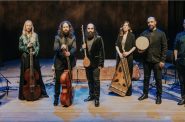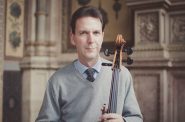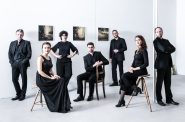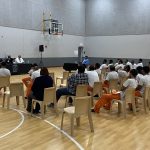Behold the Sound of Summer
Fine Arts Quartet begins its Summer Evenings of Music with a sparkling lineup of four different composers from three different centuries.

Fine Arts Quartet – violinists Ralph Evans and Efim Boico, cellist Robert Cohen and violist Juan-Miguel Hernandez
The Fine Arts Quartet begins its Summer Season of Music in a festive mood – performing works rarely heard on strings. The Quartet (violinists Ralph Evans and Efim Boico, cellist Robert Cohen and violist Juan-Miguel Hernandez) will be joined by guest artist Gil Sharon on both violin and viola.
Three works are by Wolfgang Amadeus Mozart, with some assistance from Johann Sebastian Bach. Mozart admired the work of Bach, especially his mastery of fugal forms. When analyzing Bach’s major keyboard study, The Well-Tempered Klavier, Mozart created string transcriptions of six sections. The Fine Arts Quartet will play the second – Mozart-Bach, Prelude & Fugue No.2 (K.404a). Perhaps it would be better to refer to the work as Bach-Mozart. As Cohen notes, “There is not a note that isn’t Bach.” Bach wrote no works for string quartet or trio, so this is an opportunity to bring some Bach into a Fine Arts Quartet program.
When he was 16, during his summer in Salzburg, Mozart created three Divertimenti, K.136, 137, and 138, also known as the Salzburg Symphonies. The Quartet will play the second Divertimento (K 136). A divertimento is a form of suite in several movements, somewhat lighter in style, but closer to a serenade. Mozart wrote more than 20 divertimenti, not only for different combinations of string ensembles, including string orchestra, but also for wind instruments. K.137 has only three movements, rather in the form of an Italian symphony. The first lovely movement of K.137 opens gently, follows with a rapid movement, and concludes with one of great clarity and beauty.
Mozart composed an alternative slow movement to his fifth violin concerto to substitute for one thought to be too academic. The resulting Adagio (K.261) has earned its own place in the repertory. This richly romantic work challenges the classification of Mozart as a “Classical period” composer. “A genius composer obliterates those boundaries,” Cohen suggests. The work is full of “soulful darkness and brilliance .. volatile emotions.” The Quartet will perform the work as a “concerto” with guest violinist Gil Sharon taking the flights of virtuosic fancy backed by the Quartet as the “orchestra.”
Sharon is a frequent guest with the Fine Arts Quartet. In 1992, he founded the Amati Ensemble. The Ensemble performs in many different combinations, from duo to full-scale chamber orchestra. In addition to many recordings, the Amati Ensemble has performed its own chamber music series in Maastrich, Holland. Sharon primarily plays the violin, but he usually contributes to Fine Arts Quartet concerts as a violist. Sunday’s concert offers a rare chance to hear a renowned violinist on his “proper” instrument in a solo role.
The most light-hearted work on the program is by Johann Strauss Jr — the Overture to Die Fledermaus. Strauss Jr. first created the Viennese version of the operetta – more similar to American musicals than to opera. It has become a Vienna New Year’s tradition to hear Die Fledermaus in a cafe or coffee house. In the early 1880’s Johann Maierhoffer, presumably a friend of the composer, arranged one of the earliest and best renditions for string quartet, which Strauss Jr, it is said, found to be quite good. We are “by no means a full orchestra,” Cohen observes, “so the objective is to make everybody smile. This is a sorbet in the meal.”
I have always been drawn to a light dance rhythm introduced by the cello in the opening movement of this quintet. Cohen acknowledges, “it’s so unusual .. (full of ) virtuosic brilliance all the time (that) can make you smile.”
Preview
-
Concert Blends European and Persian Music
 Apr 1st, 2024 by Michael Barndt
Apr 1st, 2024 by Michael Barndt
-
Tamás Varga Guest Stars With Frankly Music
 Mar 11th, 2024 by Michael Barndt
Mar 11th, 2024 by Michael Barndt
-
Swiss Early Music Ensemble Will Play The Music of Da Vinci
 Feb 21st, 2024 by Martha Brown
Feb 21st, 2024 by Martha Brown

















So great to hear more about Mozart’s life, and about this concert series! Thank you, Michael Brandt!